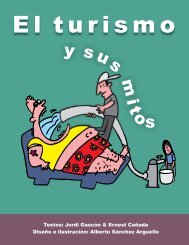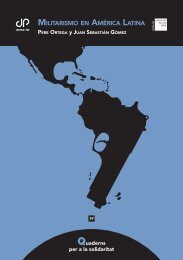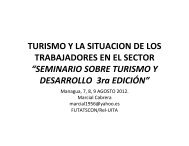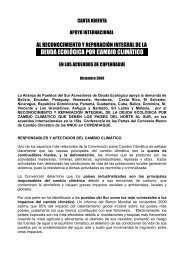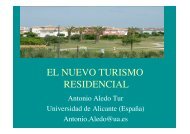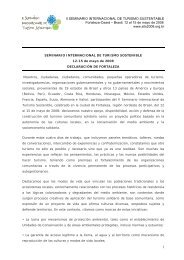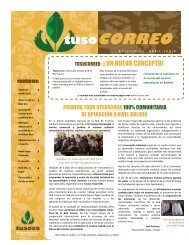Beyond Greening - Tourism Watch
Beyond Greening - Tourism Watch
Beyond Greening - Tourism Watch
Create successful ePaper yourself
Turn your PDF publications into a flip-book with our unique Google optimized e-Paper software.
<strong>Beyond</strong> <strong>Greening</strong>: Reflections on <strong>Tourism</strong> in the Rio-Process | Positioningpaperreached the point that the authorities of the Catholic Church referred to it in a pastoral letterby Monsignor Victorino Girardi from the diocese of Tilarán-Liberia, who stated: “We notewith sorrow that whereas in various coastal communities of Santa Cruz there is an alarmingshortage of water in the summer, the same does not occur in the neighbouring hotels, wherewater is not rationed and is wasted in large quantities” (Girardi, 2009, p. 14). This led thebishop to call for a moratorium on all projects requiring large amounts of water to allow for athorough review of how it was being distributed, and a second moratorium specifically for anytourism initiatives to assess their impact before allowing any more hotel chains to establishthemselves in the area.This conflict of interests has resulted in a series of conflicts that have become notorious inrecent years, with emblematic cases such as the attempts to control the aquifer of theNimboyores river by the Hotel Meliá Conchal – Reserva Conchal, or the aquifer of El Sardinalby a group of entrepreneurs, who with backing from the government wanted to build anaqueduct that would carry water to the residential and tourist projects at Playa del Coco andPlaya Hermosa. The seriousness of these events led the United Nations, through its HumanRights Council, to issue a report urging the Government “to take all appropriate measures toensure the effective participation of the communities affected in monitoring the application ofthe project, with a view to ensuring the sustainable management and use of the Sardinalaquifer” (United Nations, 2009).Environmental impactsDespite describing itself as “an industry without chimneys,” the dominant tourist model hasmajor and serious environmental impacts, which transform, degrade and artificialise thesurrounding environment, in a process of adaptation and homogenisation of the landscapebased on certain advertising and commercial images. A common and recurring situation is thedestruction of mangrove swamps. These habitats are not only vital to reduce vulnerabilitywhen faced with certain natural phenomena, such as tsunamis, but also as producers of animaland plant life. The disappearance of such habitats, which is common in the construction ofnew tourist enclaves in virgin areas, has a major effect on the environment and on how artisanfishing communities make a living. A recent example, which is particularly striking because ofits absurdity, can be found in one of the proposals put forward by tourist business interests inEl Salvador, grouped together as the Association of Sea Coast <strong>Tourism</strong> Developers(PROMAR). Among the initiatives for which it wanted public support, it proposed theconstruction of an airport on Isla Perico in the Gulf of Fonseca, in a protected area containinglarge mangrove swamps. Fortunately these demands clashed with the position held by theMinistry of the Environment and Natural Resources, which took an opposing view and optedto protect the mangroves and reactivate artisan fishing.However, the stockpiling of essential resources and the degradation of ecosystems due to thepenetration of large tourist companies is also leading to a breaking up of the territoriality ofrural communities. These do not live solely within the limits of the plots of land that theyown, but rather they occupy and reproduce (materially and culturally) in much broaderspaces, which allow them to come together as a group. The closure of traditional paths or thedisplacement and distancing from their means of livelihood, as is the case of fishingpopulations moved inland to make way for coastal tourism, strangles the traditionalfunctioning of rural communities.39



